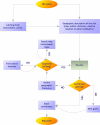Assembling a global database of malaria parasite prevalence for the Malaria Atlas Project
- PMID: 17306022
- PMCID: PMC1805762
- DOI: 10.1186/1475-2875-6-17
Assembling a global database of malaria parasite prevalence for the Malaria Atlas Project
Abstract
Background: Open access to databases of information generated by the research community can synergize individual efforts and are epitomized by the genome mapping projects. Open source models for outputs of scientific research funded by tax-payers and charities are becoming the norm. This has yet to be extended to malaria epidemiology and control.
Methods: The exhaustive searches and assembly process for a global database of malaria parasite prevalence as part of the Malaria Atlas Project (MAP) are described. The different data sources visited and how productive these were in terms of availability of parasite rate (PR) data are presented, followed by a description of the methods used to assemble a relational database and an associated geographic information system. The challenges facing spatial data assembly from varied sources are described in an effort to help inform similar future applications.
Results: At the time of writing, the MAP database held 3,351 spatially independent PR estimates from community surveys conducted since 1985. These include 3,036 Plasmodium falciparum and 1,347 Plasmodium vivax estimates in 74 countries derived from 671 primary sources. More than half of these data represent malaria prevalence after the year 2000.
Conclusion: This database will help refine maps of the global spatial limits of malaria and be the foundation for the development of global malaria endemicity models as part of MAP. A widespread application of these maps is envisaged. The data compiled and the products generated by MAP are planned to be released in June 2009 to facilitate a more informed approach to global malaria control.
Figures





Similar articles
-
A new world malaria map: Plasmodium falciparum endemicity in 2010.Malar J. 2011 Dec 20;10:378. doi: 10.1186/1475-2875-10-378. Malar J. 2011. PMID: 22185615 Free PMC article.
-
A world malaria map: Plasmodium falciparum endemicity in 2007.PLoS Med. 2009 Mar 24;6(3):e1000048. doi: 10.1371/journal.pmed.1000048. PLoS Med. 2009. PMID: 19323591 Free PMC article.
-
Folic acid supplementation and malaria susceptibility and severity among people taking antifolate antimalarial drugs in endemic areas.Cochrane Database Syst Rev. 2022 Feb 1;2(2022):CD014217. doi: 10.1002/14651858.CD014217. Cochrane Database Syst Rev. 2022. PMID: 36321557 Free PMC article.
-
Mapping the global prevalence, incidence, and mortality of Plasmodium falciparum and Plasmodium vivax malaria, 2000-22: a spatial and temporal modelling study.Lancet. 2025 Mar 22;405(10483):979-990. doi: 10.1016/S0140-6736(25)00038-8. Epub 2025 Mar 5. Lancet. 2025. PMID: 40056919 Free PMC article.
-
Malaria Molecular Epidemiology: An Evolutionary Genetics Perspective.Microbiol Spectr. 2019 Jul;7(4):10.1128/microbiolspec.ame-0010-2019. doi: 10.1128/microbiolspec.AME-0010-2019. Microbiol Spectr. 2019. PMID: 31400095 Free PMC article. Review.
Cited by
-
A new world malaria map: Plasmodium falciparum endemicity in 2010.Malar J. 2011 Dec 20;10:378. doi: 10.1186/1475-2875-10-378. Malar J. 2011. PMID: 22185615 Free PMC article.
-
Standardizing estimates of the Plasmodium falciparum parasite rate.Malar J. 2007 Sep 25;6:131. doi: 10.1186/1475-2875-6-131. Malar J. 2007. PMID: 17894879 Free PMC article.
-
Assembling a geospatial database of tsetse-transmitted animal trypanosomosis for Africa.Parasit Vectors. 2014 Jan 21;7:39. doi: 10.1186/1756-3305-7-39. Parasit Vectors. 2014. PMID: 24447638 Free PMC article.
-
A world malaria map: Plasmodium falciparum endemicity in 2007.PLoS Med. 2009 Mar 24;6(3):e1000048. doi: 10.1371/journal.pmed.1000048. PLoS Med. 2009. PMID: 19323591 Free PMC article.
-
Malaria distribution, prevalence, drug resistance and control in Indonesia.Adv Parasitol. 2011;74:41-175. doi: 10.1016/B978-0-12-385897-9.00002-1. Adv Parasitol. 2011. PMID: 21295677 Free PMC article. Review.
References
Publication types
MeSH terms
Grants and funding
LinkOut - more resources
Full Text Sources
Medical
Research Materials

